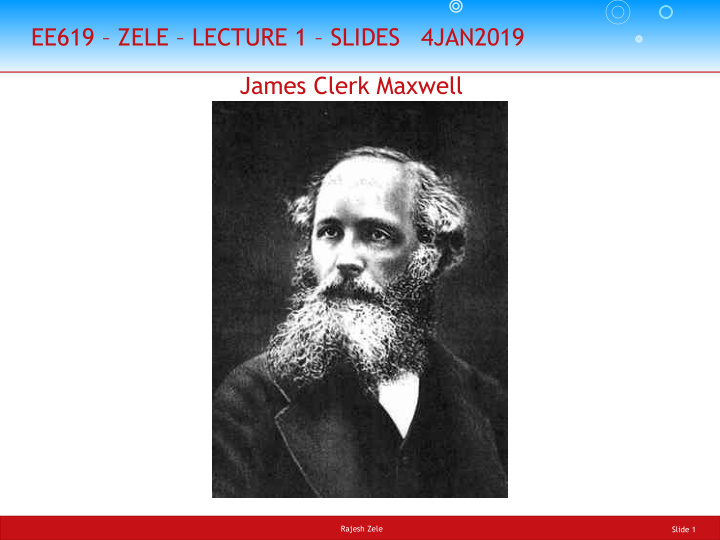



EE619 – ZELE – LECTURE 1 – SLIDES 4JAN2019 James Clerk Maxwell Rajesh Zele Slide 1
Heinrich Hertz source: wikipedia Rajesh Zele Slide 2
Jagadish Chandra Bose source: wikipedia Rajesh Zele Slide 3
Point contact diodes – JC Bose Rajesh Zele Slide 4
Guglielmo Giovanni Maria Marconi source: wikipedia Rajesh Zele Slide 5
Attenuation vs frequency Rajesh Zele Slide 6
Why RF? RF / Wireless Transfer of information from one point to another without any physical medium RF propagation Power radiated is inversely proportional to (frequency) 2 and (distance) 2 Longer wavelength (low frequency) signals travel greater distance and penetrate through objects better Antenna size is proportional to wavelength (1/frequency) Frequency Wavelength Antenna Size 900 Mhz 33.33 cm 16.67 cm 2.4 Ghz 12.5 cm 6.25 cm 60 Ghz 5 mm 2.5 mm Rajesh Zele Slide 7
Basic RF circuit functions Desired Signal Signal Strength Frequency Objective amplify only the desired signal in presence of the device/ambient noise in presence of the strong undesired signals condition the signal for digital processing reliable over process, temperature, voltage variations Rajesh Zele Slide 8
RF transceiver architecture – Direct Conversion Rajesh Zele Slide 9
Technology Trends Slide 10
Number of devices in the Internet of Everything Rajesh Zele Slide 11
Trends in Wireless Networks Smith et. al. Solid-state circuits magazine 2012 Rajesh Zele Slide 12
Technology Trends Body Area Network: Next Gen Healthcare BCC: Human Body as Transmission medium Tech Trends ISSCC 2011 Rajesh Zele Slide 13
Technology Trends – wired and wireless data-rates over time Tech Trends ISSCC 2015 Rajesh Zele Slide 14
Summary – Technology Trends Radios coming closer to Human body (inside?) Drive towards – Low power short range transceivers 60 GHz Radios – High bandwidth & Smaller antennas Wireline 100 Gbps to support big data Optical networking Software defined radios ? Full spectrum capture Radios All this with nm CMOS Technology Rajesh Zele Slide 15
CMOS Technology and Supply voltage scaling C-H Jan, IEDM 2010) Driven by Digital to pack more functionality per sqmm. Supply voltage reduced for various junction breakdown. Rajesh Zele Slide 16
CMOS Technology scaling Parameter Scaling Factor L, W, Tox 1/S Voltage S 0.7X Electric Field 1 Doping Conc. S Current 1/S Gate Delay 1/S Power 1/S 2 Constant Field scaling (Dennard 1974) Each generation of CMOS scales with Example: 90nm, 65nm, 45nm, 28nm CMOS technologies Huge performance improvements for Digital circuits Rajesh Zele Slide 17
Scaling Impact on Analog circuits Rajesh Zele Slide 18
f t scaling trend Higher f t – higher frequency circuit operation mm-Wave 60 GHz now possible in CMOS High frequency converters with better resolution Full spectrum capture possible! C-H Jan, IEDM 2010) Rajesh Zele Slide 19
Integration Trends in Wireless Transceivers Tech Trends ISSCC 2015 Rajesh Zele Slide 20
G. Chien, F. Weishi, Y.A. Hsu, and L. Tse. A 2.4ghz cmos transceiver and baseband processor chipset for 802.11b wireless lan application ISSCC, 2003 Rajesh Zele Slide 21
B.-E. Kim et al.A 9dbm iip3 direct-conversion satellite broadband tuner-demodulator SOC. ISSCC, 2003 Rajesh Zele Slide 22
A Single-Chip CMOS Bluetooth v2.1 Radio SoC W. W. Si et al ., "A Single-Chip CMOS Bluetooth v2.1 Radio SoC," in IEEE Journal of Solid-State Circuits , vol. 43, no. 12, pp. 2896-2904, Dec. 2008. doi: 10.1109/JSSC.2008.2005741 Rajesh Zele Slide 23
State-of-Art RFIC – Trends and Challenges Moving up to 60 Ghz Lumped vs. distributed behavior EM simulations Multimode radios Diversity Multiple front ends on the chip Multiple VCOs – Frequency planning important SOC challenges Sensitive RF circuits on the noisy digital substrate Substrate noise coupling and crosstalk Magnetic coupling between on-chip spiral inductors. Spurs Rajesh Zele Slide 24
Beyond IC design Package Modeling, Chip Pinouts, Coupling between different bond-wires, Board layout, Component models MUST be part of design flow. J. Long – ISSCC 05 Rajesh Zele Slide 25
Recommend
More recommend